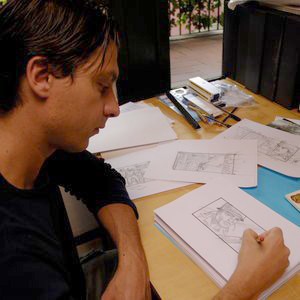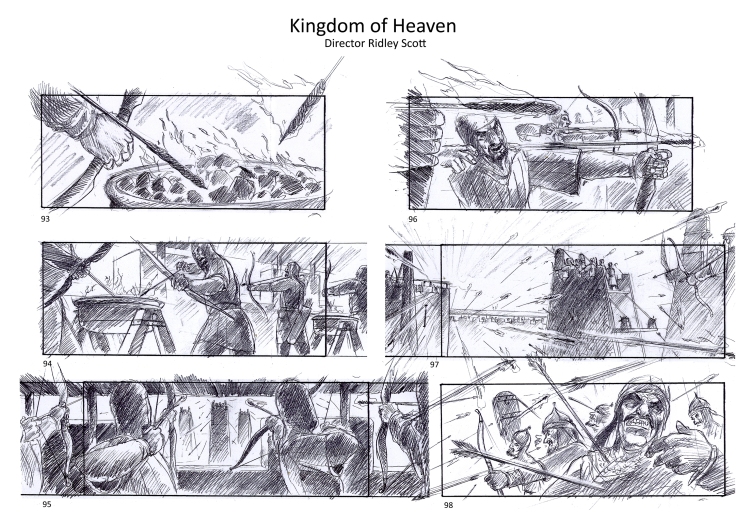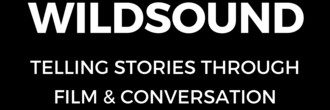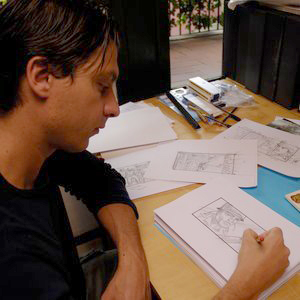A storyboard artist, or story artist, creates storyboards for film productions.
Storyboard Artist Cristiano Donzelli is a wealth of knowledge. You can feel his passion for what he does. No wonder all of the top filmmakers in the world who venture to Italy want to work with him. He simply makes all the films he storyboards better.
Cristiano’s credits include Kingdom of Heaven (2005), Rome (2005). Zoolander 2 (2016), The American (2010). Ben-Hur (2016), The Young Messiah (2016), and Under the Tuscan Sun (2003)
Go to his website at www.cristianodonzelli.com

Matthew Toffolo: You have been the storyboard artist on over 40 productions in the last 20 years. Is there a film or two that you’re most proud of?
Cristiano Donzelli: First of all I want to say that I do this work because I love cinema, I’m very passionate about movies, so for me it’s not just a job, it’s more than that. After weeks of drawing the scenes of a film, developing it with the director and seeing it growing little by little, it becomes part of you. So each film I worked for, has been a unique experience, so I’m equally proud of all of them.
MT: Ben Stiller sings your praises. You just worked with him on “Zoolander 2”. What can you say about the Ben Stiller experience?
CD: Ben Stiller is an icon in the film industry and Zoolander is a cult movie so when they called me to work on Zoolander 2 I already knew that would be an important and funny experience for me. I worked with Ben Stiller for four months and we shared so many laughs while working. He’s a good person and such a great artist, always full of ideas and I can say he has the comedy in his blood. He asked me to use my creativity to imagine gags and re-write together the scenes of the script with the storyboards. He’s a very sensitive person and I can say the film business didn’t change his genuineness, enthusiasm and sincere approach to his work.
PHOTO: Cristiano with Ben Stiller:

MT: Can you give us a teaser of what we’ll expect to see in “Ben-Hur”? How was it to work on the remake of such an iconic film? That’s seems like it would be a very daunting and overwhelming task!
CD: Too bad I can’t tell you anything about it, as you may know before starting to work in a film production, an artist has to sign an NDA so he can’t tell anything about the movie before it’s out on the screens. The only thing I can say is that it’ll be very spectacular and visually great. I’ve worked closely for months with the director Timur Bekmambetov, the second unit director Phil Neilson and with the VFX supervisor Jim Rygiel (3 Oscar winning for the Lords of Ring trilogy), creating spectacular action scenes especially for the iconic chariots race scene that won’t delude the old Ben Hur movie fans.
MT: You’ve also directed some short films, commercials, and music videos. Is directing something you like to do more professionally? Is directing a Hollywood feature film your ultimate goal?
CD: I’ve been second unit director for James McTeigue (V for Vendetta director) in his project “Caserta Palace Dream”, I directed over 40 tv commercials, three music videos and the 30 minute short film “Una Storia Di Lupi – aka A Wolves Tale” that stars Franco Nero as main actor that won two important film festivals as best short. I was born with a passion for drawing, then I realized that I had a great passion for directing too. When I was a child my father often took me to the cinema and since then I had this dream to work in the film industry and be a director. I’m developing different projects and writing treatments, so yes, directing a Hollywood feature film is my next goal.
MT: What’s the general working relationship and process between a storyboard artist and the director? How early do you meet before production begins?
CD: It depends on the project, sometimes they call me very early even before the pre-production just because the director and the producers want to have an idea about how the film will be and how much it’ll cost more or less for each scene. Other times they call me later, when the locations and the sets are decided so the director can give me more precise information about the scenes. The general working relationship between me and a director is also something different each time. Some directors have very clear ideas about what they wants, some others give you the script directly and ask you to do all by yourself. He assigns you the responsibility to take decisions choosing the shots, in some way it’s like if you direct part of the movie. Between me and a director there is an artistic exchange, you give something to him but you also get something from him, his vision, his way of tell a story and most important, you know closely a person and an artist.
MT: What are you looking for in a director?
CD: Maybe the question should be “what a director usually looks for in a storyboard artist?” I would answer that a director wants to work with a person who is able to understand his vision of a story, who is able to give ideas, understand the possible problems of a complicated scene and give solutions, be able to show with his drawings all the information that a storyboard has to provide to all the different departments in a movie productions. And above all I think a director wants to find a person to be comfortable with because he will have to spend weeks with him.
CD: I had the chance to work with so many directors, Ridley Scott, Martin Scorsese, Spike Lee, Paul Haggis, Kevin Reynolds, Brian Helgeland, Ben Stiller and with many of them, besides a professional relationship, I cultivate a good friendship.
MT: Do you have a Storyboard mentor?
CD: Actually I have no specific mentor, I am a self taught, I learnt everything by myself. I spent hours drawing and watching movies, sectioning them, trying to learn the language of telling a story with images, the framing and the editing. There are a lot of good storyboard artists around and I like their work. Sometimes I take some inspiration from them as all the artists do with other artists’ work.
MT: You have worked on a lot of Action films. How important is the creation of the storyboard to the production team for the action and fight scenes?
CD: Very important. A storyboard is the translation of written pages in images, it’s the first virtual visualization of a story. So the director can see his movie before shooting it and explain to the producer, to the director of the photography, to the production designer and all the departments, what’s his idea of the film. Thanks to the storyboard you can also have an idea about all the problems you’ll have to deal with and find solutions before the shooting. In particular for the action scenes just because they can be very complicated to shoot, the storyboard can allow the team to prepare properly special effects, to coordinate stunts, to arrange everything that is needed, and most important to give to the producer an estimation of the costs for each scene.
MT: Besides the films you’ve worked on, what movie have you seen the most in your life?
CD: Once upon a time in America, Blade Runner.
MT: Do you have any advice for high school and university students who want to work in the film industry?
CD: As I said I am a self taught, what drove me along my life was my love for drawing and passion for movies. I can’t suggest any specific school because I don’t know it directly. My opinion is that first of all anyone who wants to work in the film industry has to have a strong will and passion for this work, no school or university can ever give you that. Of course the schools can give you the basics, the technique and teach you every other thing you need but what’s important to succeed in the film industry is the determination, the passion and the love for your job. And this is the best teaching for everything you care about in your life, always give it your best.
PHOTO: Cristiano’s Storyboards on KINGDOM OF HEAVEN. Director Ridley Scott:


_____
Interviewer Matthew Toffolo is currently the CEO of the WILDsound FEEDBACK Film & Writing Festival. The festival that showcases 10-20 screenplay and story readings performed by professional actors every month. And the FEEDBACK Monthly Festival held in downtown Toronto on the last Thursday of every single month. Go to www.wildsound.ca for more information and to submit your work to the festival.


Reblogged this on Festival Reviews.
LikeLike
Reblogged this on WILDsound Writing and Film Festival Review.
LikeLike
Reblogged this on Under 5 minute film festival.
LikeLike
Reblogged this on Under 5 minute film festival.
LikeLike
Reblogged this on Action/Adventure Film & Screenplay Festival.
LikeLike
Reblogged this on Thriller/Suspense Film and Writing Festival.
LikeLike
Reblogged this on Festival for HORROR.
LikeLike
Reblogged this on FEEDBACK Animation Film & Screenplay Festival.
LikeLike
Reblogged this on Festival for Drama in Film, Screenplays, Novels.
LikeLike
Reblogged this on Festival Reviews.
LikeLike
Reblogged this on WILDsound Writing and Film Festival Review.
LikeLike
Reblogged this on WILDsound Writing and Film Festival Review.
LikeLike
Reblogged this on Documentary Short Film Festival.
LikeLike
Reblogged this on Fantasy/Sci-Fi FILM & WRITING FESTIVAL.
LikeLike
Reblogged this on WILDsound Writing and Film Festival Review.
LikeLike
Reblogged this on Romance Film & Screenplay Festival – Submit your romance genre screenplay or short film and get it showcased at the FEEDBACK Film Festival.
LikeLike
Reblogged this on WILDsound Writing and Film Festival Review.
LikeLike
Reblogged this on WILDsound Writing and Film Festival Review.
LikeLike